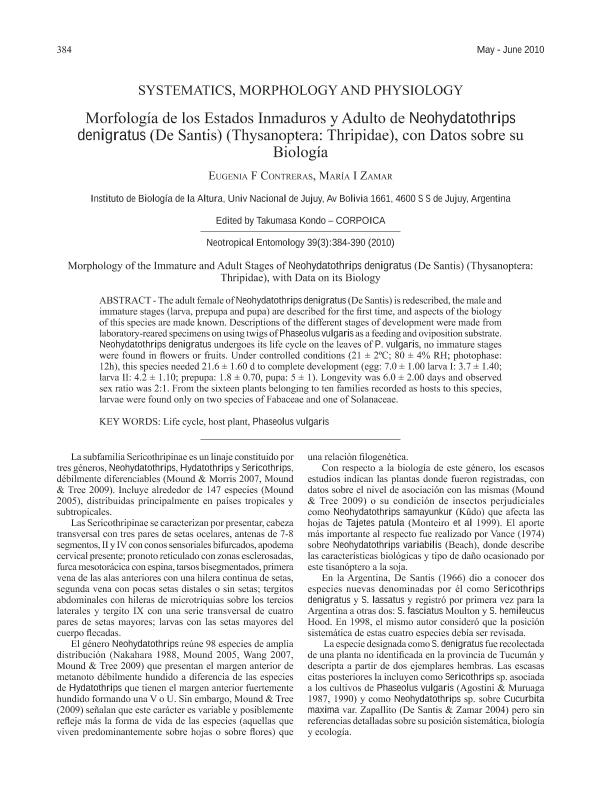Artículo
Morfología de los Estados Inmaduros y Adulto de Neohydatothrips denigratus (De Santis) (Thysanoptera: Thripidae), con Datos sobre su Biología
Título:
Morphology of the Immature and Adult Stages of Neohydatothrips denigratus (De Santis) (Thysanoptera: Thripidae), with Data on its Biology
Fecha de publicación:
06/2010
Editorial:
Sociedade Entomológica do Brasil
Revista:
Neotropical Entomology
ISSN:
1519-566X
e-ISSN:
1678-8052
Idioma:
Español
Tipo de recurso:
Artículo publicado
Clasificación temática:
Resumen
The adult female of Neohydatothrips denigratus (De Santis) is redescribed, the male and immature stages (larva, prepupa and pupa) are described for the fi rst time, and aspects of the biology of this species are made known. Descriptions of the different stages of development were made from laboratory-reared specimens on using twigs of Phaseolus vulgaris as a feeding and oviposition substrate. Neohydatothrips denigratus undergoes its life cycle on the leaves of P. vulgaris, no immature stages were found in fl owers or fruits. Under controlled conditions (21 ± 2ºC; 80 ± 4% RH; photophase: 12h), this species needed 21.6 ± 1.60 d to complete development (egg: 7.0 ± 1.00 larva I: 3.7 ± 1.40;larva II: 4.2 ± 1.10; prepupa: 1.8 ± 0.70, pupa: 5 ± 1). Longevity was 6.0 ± 2.00 days and observed sex ratio was 2:1. From the sixteen plants belonging to ten families recorded as hosts to this species, larvae were found only on two species of Fabaceae and one of Solanaceae.
Palabras clave:
LIFE CYCLE
,
HOST PLANT
,
PHASEOLUS VULGARIS
,
NEOHYDATOTHRIPS DENIGRATUS
Archivos asociados
Licencia
Identificadores
Colecciones
Articulos(CCT - SALTA-JUJUY)
Articulos de CTRO.CIENTIFICO TECNOL.CONICET - SALTA-JUJUY
Articulos de CTRO.CIENTIFICO TECNOL.CONICET - SALTA-JUJUY
Citación
Contreras, Eugenia Fernanda; Zamar, María Inés; Morfología de los Estados Inmaduros y Adulto de Neohydatothrips denigratus (De Santis) (Thysanoptera: Thripidae), con Datos sobre su Biología; Sociedade Entomológica do Brasil; Neotropical Entomology; 39; 3; 6-2010; 384-390
Compartir




